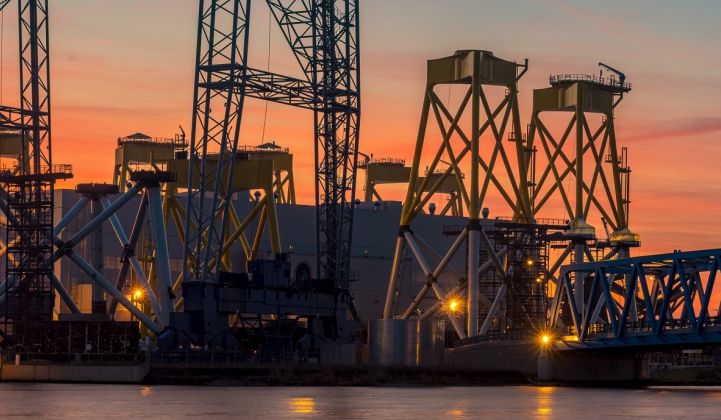COPENHAGEN — Demands for local content and manufacturing are growing louder in many offshore wind markets, and that includes the world's most advanced and locally supplied market: Europe.
Tensions around local content are likely to increase as deployment ramps up in new European markets, with France, Ireland, Poland and the Baltic countries adding to the current concentration of European activity in the U.K., Germany and the Benelux nations.
Even in the U.K., the world's largest offshore wind market, local content is growing as a political issue. Unions have criticized EDF’s decision to have jackets for its Neart na Gaoithe project in Scotland made in Indonesia.
The so-called Sector Deal announced by the U.K. government and industry earlier this year set out a non-binding proposal to gradually build up the proportion of local content going into U.K. offshore wind farms from a target of 50 percent today to 60 percent by 2030. The Scottish government has said it would like these firmed up by integrating them into the auction process.
Danielle Lane, U.K. country manager for the developer Vattenfall, noted that the Sector Deal is a political document that provides a policy framework for the industry. Regardless of whether or not it is binding, it is being praised in other markets as an example of good practice, she said.
“The local content debate is a hot topic anywhere you go. If you go to France, they are very keen on local content. If you go to Poland, they are very keen on local content. I think it's fair to say that what we try to do as a developer is to deliver what we can to meet the expectations of the market that we're operating in.”
“Supply chains are global, and I think we have to be very aware of the tension between cost reductions, that we've been driven hard to deliver, and [local] content,” she added. “We all have to be conscious of the reality. We're not going to see a turbine manufacturing facility set up in every market.”
Overly restrictive local content rules could slow the deployment of offshore wind and therefore progress toward decarbonization, warned Kasper Yttesen, executive vice president at turbine supplier Siemens Gamesa, speaking at WindEurope’s Offshore 2019 event last week in Denmark.
“I would rather we had the freedom of optimizing our footprint because that will eventually give the competitive edge also to the industry and for the green transition,” Yttesen told GTM.
Offshore wind is viewed as a central component of long-term climate and energy plans in Europe. The European Commission estimates that 450 gigawatts of offshore wind will be needed by 2050 if Europe is to decarbonize. The event in Copenhagen coincided with the European Parliament declaring a climate emergency, offering another political signal that the levels of ambition in the EU will be ramped up.
That is precisely what seven of the continent’s largest energy companies (PDF) called for in an open letter last week. The signatories, including Ørsted, SSE and Enel, back an increase in the 2030 greenhouse gas reductions versus 1990 levels from the current target of 40 percent to 55 percent.
Simon Cox, head of offshore wind for northern Europe at the technical advisory firm DNV GL, said the certainty of offshore wind pipelines is critical for building up reliable supply chains.
“To have a working supply chain, there needs to be a clear market with a clear plan. And that plan needs to be for this year, next year and each subsequent year afterward; it can’t cope with boom and bust," Cox said.
"The more obligations...put on projects [and] on development do mean more challenges,” said Cox. He pointed to Taiwan as an example where collaboration between government and industry has enabled a healthy pipeline to build up very quickly.
Siemens Gamesa's Yttesen said removing unwelcome government intervention enables his company to offer developers the best possible prices, which in turn helps the sector to fulfill its central role in decarbonization.
Siemens Gamesa's 2019 offshore turbine orders topped 3 gigawatts, and Yttesen foresees handling order volumes of up to 5 gigawatts through 2023. As of November this year, the company has 5 gigawatts of firm offshore orders and 7 gigawatts of conditional offshore orders.
The global supply chain will be stretched as the market takes off in Taiwan and the U.S.
"If the [existing] volumes are spread globally, and you also need to bring local factories everywhere, then from a supply chain perspective, that makes it harder to optimize," he said.




